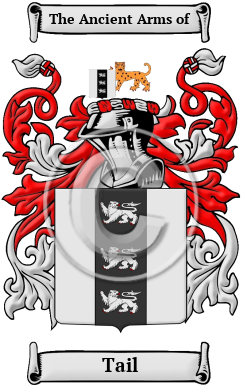| ![Show Contents]() Tail History, Family Crest & Coats of Arms Tail History, Family Crest & Coats of Arms
Etymology of TailWhat does the name Tail mean? During the Middle Ages, the surname of Tail was used in Scotland. While the patronymic and metronymic surnames, which are derived from the name of the father and mother respectively, are the most common form of a hereditary surname in Scotland, occupational surnames also emerged during the late Middle Ages. Many people, such as the Tail family, adopted the name of their occupation as their surname. However, an occupational name did not become a hereditary surname until the office or type of employment became hereditary. The surname Tail was an occupational name for a tailor. Interestingly, the name Tail was originally derived from the Anglo Norman French word taillour, meaning tailor. 1 Early Origins of the Tail familyThe surname Tail was first found in many places throughout Scotland. Some of the early records include: Alexander le Tayllur who was valet of Alexander in 1276; John le Taillur who was held the mill of Selkirk as firmar in 1292; and Brice le Taillur who was one of the Scottish prisoners taken at the capture of Dunbar Castle in 1296. The last entry's year is of great significance to the surname and indeed to much of Scotland; for it was that year that King Edward I invaded Scotland and insisted that the native Scots pay homage to him. Six persons of this name in the counties of Roxburgh, Dumfries, Edinburgh, Lanark, and Angus all rendered homage, 1296. 2 They held lands in Forfar, Cesseworth, Cunningham, Lanark, and Stirling in Scotland. Early History of the Tail familyThis web page shows only a small excerpt of our Tail research. Another 117 words (8 lines of text) covering the years 1292, 1376, 1645, 1729, 1779, 1784, 1850, 1890 and 1920 are included under the topic Early Tail History in all our PDF Extended History products and printed products wherever possible. Tail Spelling VariationsSpelling variations of this family name include: Taylor, Taylour, Taylur, Tailler, Taillefer and many more. Early Notables of the Tail familyNotable among the family at this time was Edward Taylor (1645-1729), who was hailed as the finest American poet of the 17th century upon the publication of his work in 1920...
Another 30 words (2 lines of text) are included under the topic Early Tail Notables in all our PDF Extended History products and printed products wherever possible. Migration of the Tail family to IrelandSome of the Tail family moved to Ireland, but this topic is not covered in this excerpt.
Another 60 words (4 lines of text) about their life in Ireland is included in all our PDF Extended History products and printed products wherever possible.
| Tail migration to Australia | + |
Emigration to Australia followed the First Fleets of convicts, tradespeople and early settlers. Early immigrants include: Tail Settlers in Australia in the 19th Century- Margaret Tail, aged 28, who arrived in Adelaide, Australia aboard the ship "Palmyra" in 1839 3
- Martha Tail, aged 31, a servant, who arrived in South Australia in 1852 aboard the ship "Charlotte Jane" 4
- William Tail, aged 25, a labourer, who arrived in South Australia in 1858 aboard the ship "Melbourne"
| Tail migration to New Zealand | + |
Emigration to New Zealand followed in the footsteps of the European explorers, such as Captain Cook (1769-70): first came sealers, whalers, missionaries, and traders. By 1838, the British New Zealand Company had begun buying land from the Maori tribes, and selling it to settlers, and, after the Treaty of Waitangi in 1840, many British families set out on the arduous six month journey from Britain to Aotearoa to start a new life. Early immigrants include: Tail Settlers in New Zealand in the 19th Century- Robert Tail, aged 43, a carpenter, who arrived in Wellington, New Zealand aboard the ship "Soukar" in 1874
- Joan S. Tail, aged 10, who arrived in Wellington, New Zealand aboard the ship "Soukar" in 1874
- Catherine Tail, aged 8, who arrived in Wellington, New Zealand aboard the ship "Soukar" in 1874
- Margaret J. Tail, aged 6, who arrived in Wellington, New Zealand aboard the ship "Soukar" in 1874
- Robert Tail, aged 3, who arrived in Wellington, New Zealand aboard the ship "Soukar" in 1874
- ... (More are available in all our PDF Extended History products and printed products wherever possible.)
- Lower, Mark Anthony, Patronymica Britannica, A Dictionary of Family Names of the United Kingdom. London: John Russel Smith, 1860. Print.
- Black, George F., The Surnames of Scotland Their Origin, Meaning and History. New York: New York Public Library, 1946. Print. (ISBN 0-87104-172-3)
- State Records of South Australia. (Retrieved 2010, November 5) PALMYRA 1839. Retrieved from http://www.slsa.sa.gov.au/BSA/1839Palmyra.htm
- South Australian Register Tuesday 3 February 1852. (Retrieved 2010, November 5) CHARLOTTE JANE 1852. Retrieved http://www.theshipslist.com/ships/australia/charlottejane1852.shtml
 |

